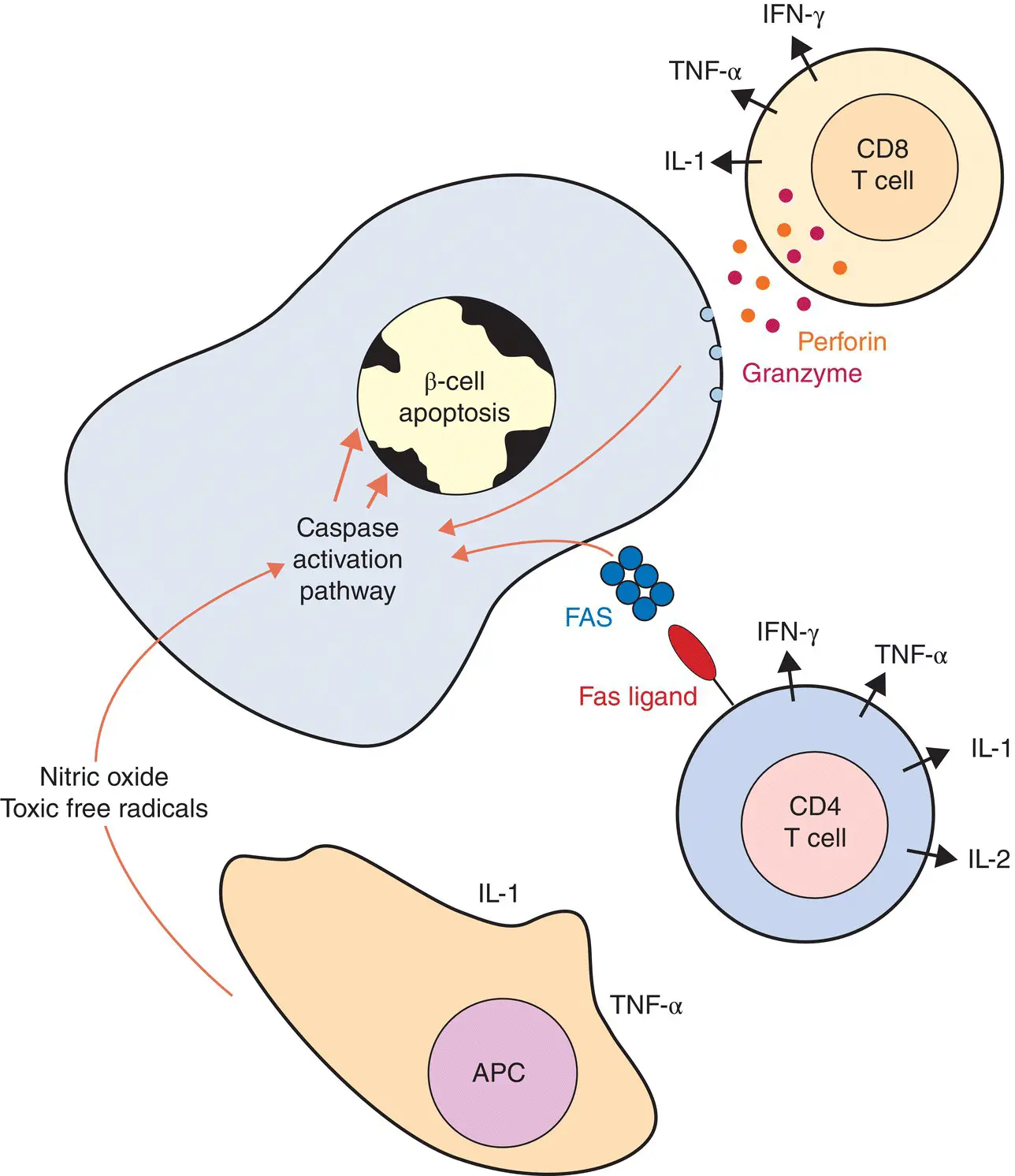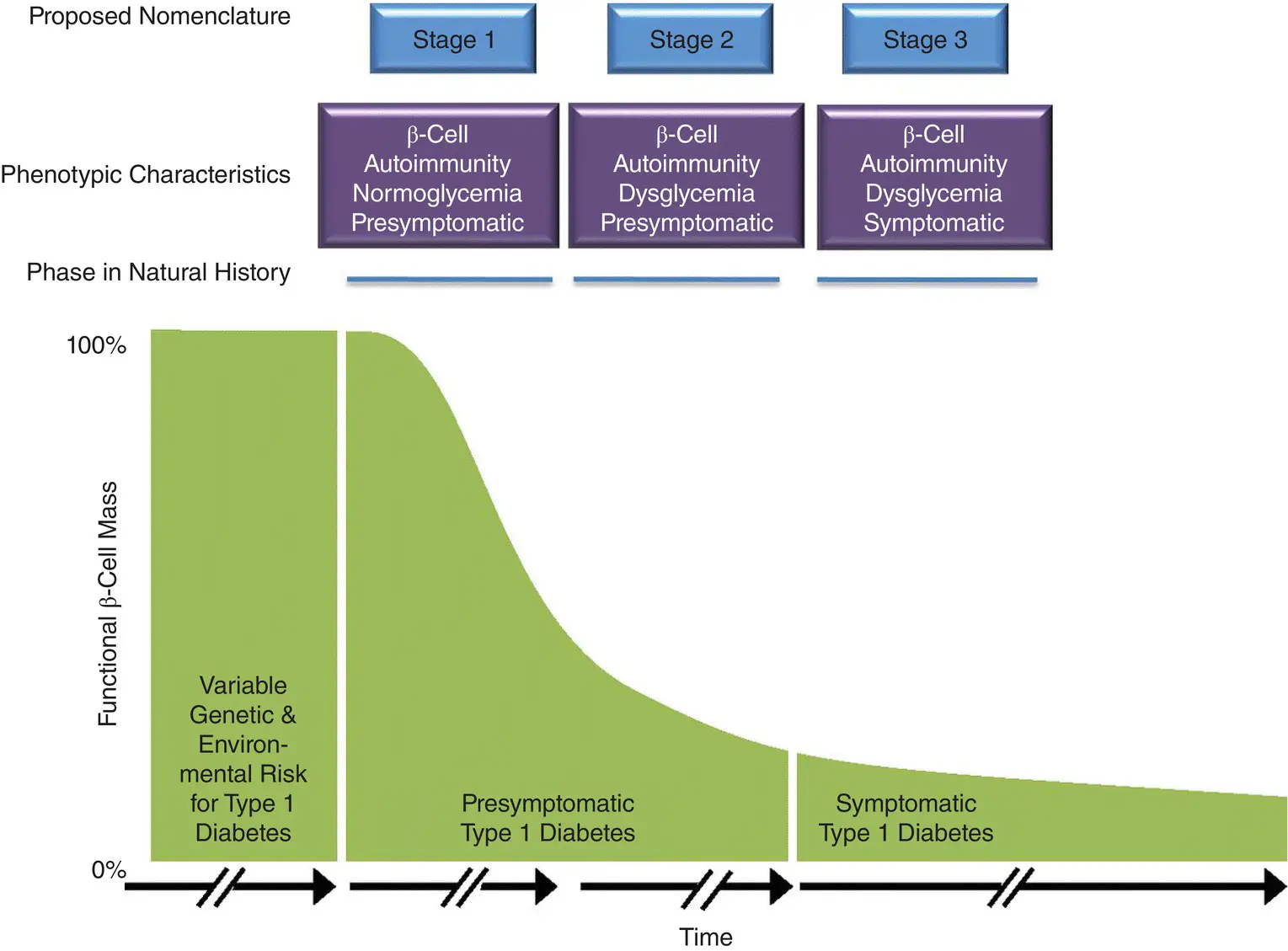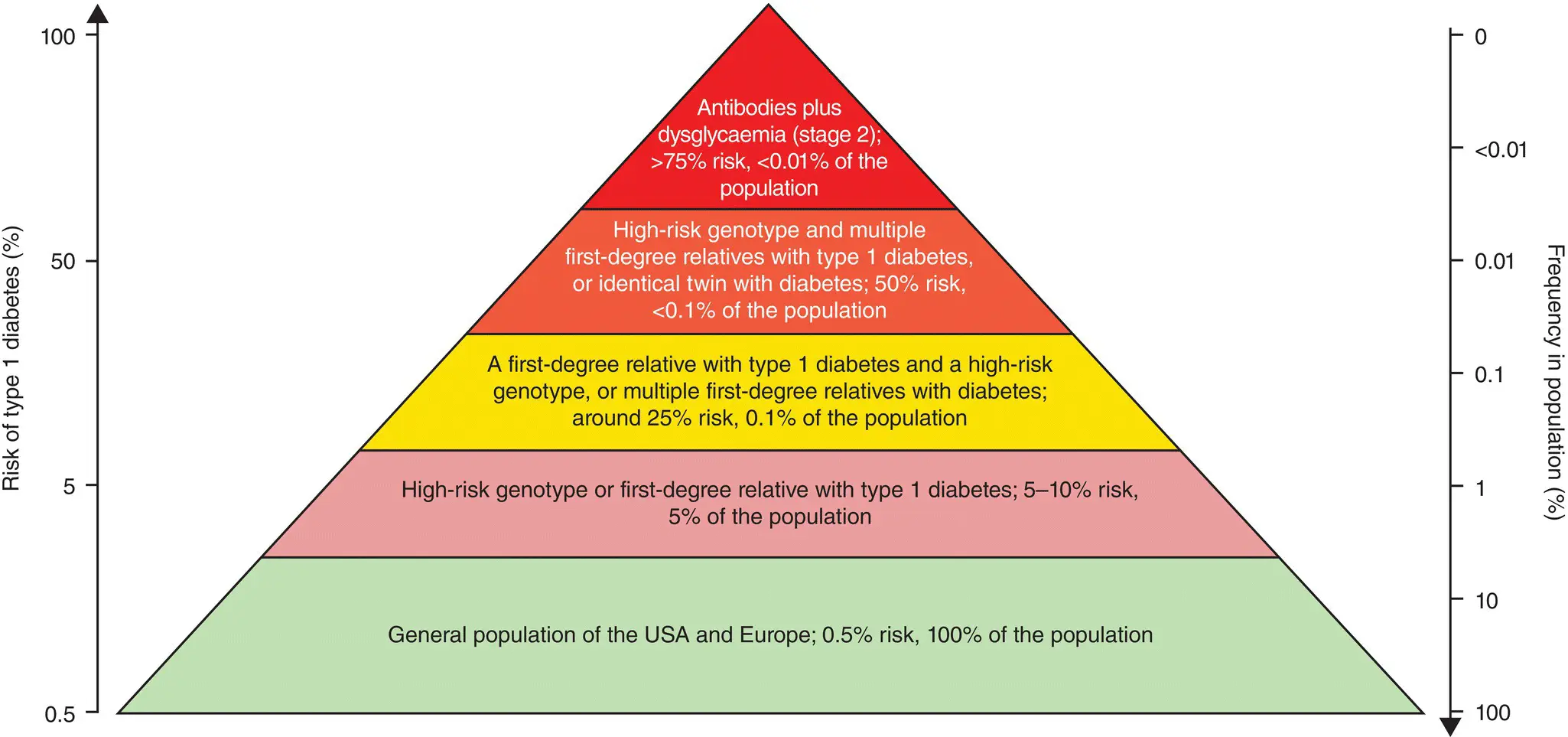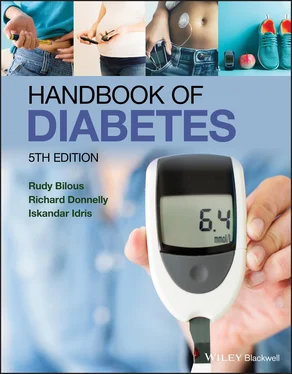
Figure 6.7 Potential mechanisms of viral aetiology of autoimmune and non‐autoimmune type 1 diabetes. IL = Interleukin; IFN = Interferon; TNF = Tumour Necrosis Factor.
Adapted from Craig ME et al Pediatr Diabetes 2013;14:149–58.

Figure 6.8 Proposed mechanisms of β cell death. β cells die through a process known as apoptosis, characterised by condensation and fragmentation of nuclear chromatin, loss of cytoplasm and expression of surface receptors that signal macrophages to ingest the apoptotic cell. Apoptosis is effected by activation of the caspase pathway.
Spontaneous diabetes that resembles type 1 diabetes in humans occurs in some animals, notably the BioBreeding (BB) rat and the non‐obese diabetic (NOD) mouse. These ‘animal models’ have many of the same characteristics as human autoimmune diabetes, including a genetic predisposition, MHC association, insulitis, circulating islet cell surface and GAD autoantibodies, a long prediabetic period that precedes overt hyperglycaemia and environmental factors that trigger or accelerate the appearance of diabetes, such as wheat and cow’s milk proteins. Many hypotheses of the causes of type 1 diabetes have been developed and tested in these animals.
The increasing incidence of atopy as well as early‐onset type 1 diabetes in Western societies may be a consequence of a lack of exposure to common pathogens such as helminth worms (so called ‘old friends’), or lactobacilli (microflora). Chronic exposure might include a more tolerant T cell response to antigens, while a cleaner, more sterile early environment would result in an exaggerated response in subsequent months or years. Some of the associated factors listed in Table 6.3would support this hypothesis.
Pregnancy is thought to have a Th2 lymphocyte orientation whilst early environmental antigen exposure stimulates Th1 responses. The first line immune response in children comprises immature dendritic cells which are primed to respond to specific antigens, and they also carry innate pattern recognition receptors that bind to viral or bacterial cell surfaces. T‐cell receptors are highly cross reactive so an immune response to common allergens or self antigens might be activated by infection. It was originally thought that an imbalance in Th1 and 2 cells would lead to a different balance in cytokine release predisposing to either autoimmunity (Th1 predominance) or allergy (Th2 predominance). However, this construct has not been supported by the observation that helminth (pinworm) exposure actually leads to a more pronounced Th2 response but lower rates of atopy. Thus, the hygiene hypothesis, despite supportive associative data, remains unproven.
The observed increase in non‐autoimmune type 1 diabetes and its links to type 2 diabetes susceptibility genes, as well as the increasing rates of obesity in children, has led to the concept of increasing insulin resistance as a cause of β cell loss. It is generally believed that β cell loss is a feature of ageing, and obesity related insulin resistance could accelerate this loss through apoptosis and be partly responsible for the increasing incidence of both type 1 and type 2 diabetes. Much of the supportive evidence remains cross sectional rather than prospective, however.
The increasing understanding of the processes leading to symptomatic type 1 diabetes has resulted in a consensus model in individuals who have a genetic susceptibility and comprises 3 stages ( Figure 6.9). Stage 1 individuals have positive autoantibodies but normal glucose tolerance. As mentioned above, increasing numbers of islet autoantibodies and increasing titres represent disease progression. Stage 2 is reached as β cell loss results in glycaemic responses to a glucose challenge becoming abnormal, but there is no universal agreement as to what the glucose stimulus should be or what threshold of blood glucose (or HbA1c) would define ‘dysglycaemia’. Both the presence of impaired fasting glucose or glucose intolerance (see Chap 3) following a 75g OGTT and a 20% increase in baseline HbA1c have a positive predictive value (PPV) of 98% for symptomatic type 1 diabetes within 5 years in prospective studies in high risk individuals, and it is known that the first phase insulin response to intravenous glucose declines rapidly 18–6 months before diabetes symptoms. Stage 3 is the development of symptomatic diabetes.
This staging has helped in the design of clinical prevention trials. Early studies focused on antigen specific (by early exposure to intravenous or oral insulin), or immunosuppressive approaches. Neither proved to be successful, partly because of the difficulty in recruiting patients at a potentially reversible stage of their disease. The most successful study used an anti‐CD3 antibody which decreased the actions of CD8 T lymphocytes on target β cells. Teplizumab was given for 14 days in a randomised controlled trial to 76 high risk (Stage 2) individuals. The intervention delayed the diagnosis of type 1 diabetes by a median of 24 months and was well tolerated, although there was a significant reactivation of EB virus disease in those with evidence of previous infection. This proof of concept trial will likely lead to further studies of this and other agents, and several are ongoing.
Screening for Type 1 Diabetes
The improvement in assays for islet autoantibodies and the development of genetic prediction models has raised the possibility of population screening for individuals at high type 1 diabetes susceptibility. The problem is that the numbers needed to be screened to identify a single case are prohibitive ( Figure 6.10) and the absence of an effective treatment means that conventional criteria for screening are not fully satisfied. The TrialNet and other research programmes aims to recruit first degree relatives of probands with type 1 diabetes and as our understanding of heritability develops, the argument for more widespread but focused screening may become stronger.

Figure 6.9 Stages of Type 1 Diabetes as proposed by the Juvenile Diabetes Research Foundation, Endocrine Society and American Diabetes Association and adopted by TrialNet for preventative studies. Autoantibodies are present many years prior to development of symptomatic diabetes (Stage 3). Prior to this those in Stage 1 have normal glucose tolerance and those in Stage 2 varying levels of hyperglycaemia below the diagnostic thresholds of diabetes. Intervention and prevention studies have largely focused on Stage 2 and 3 patients.
Reproduced from Insel RA et al. Diabetes Care 2015; 38: 1964–74 with permission.

Figure 6.10 Lifetime risk of developing Type 1 diabetes (left axis) compared to prevalence of risk in the overall population (right axis). Individuals in the apex have the highest risk of developing diabetes (>75% within 5y) but represent 0.01% (1 in 10,000) of the overall population.
Читать дальше
















